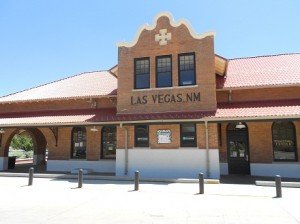
One of the best ways to learn about the history of the United States is to visit some of the historic railroad depots still in existence. There are many and each one represents a part of America’s past and it’s western expansion.Each one of these existing sites offer a real Trip Into History and most of them are free to explore and enjoy. The railroad depot can be a treasure chest of history.
Thank you for reading this post, don't forget to subscribe!Some of these are vacant buildings today but by the same token many have been preserved and converted into museums. Fortunately, the historic value of these structures was recognized by various local historical societies and were saved from the wrecking ball. Some unfortunately were not. The old railroad depots featured here are just a small sample of what is out there but hopefully it will give you an idea of how they’ve been restored. If your travels take you near any of them, I highly recommend you add some to your vacation or road trip planner.
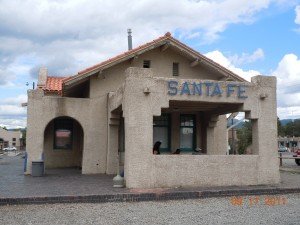
Las Vegas New Mexico
Here you have a railroad station that was constructed by the Atchison Topeka & Santa Fe Railroad in what was once one of the more popular stops on their rail line. Las Vegas was a major shipping point for livestock and wool during the late 1800’s. The AT & SF also made it into a division point which meant that maintenance buildings were erected and suitable creature comfort facilities were built including the once highly popular La Castaneda Harvey House. Both the train station and the Harvey House were built in a Mission Revival style. Today, the train station still exists as an Amtrak passenger train stop. The adjacent la Castaneda remains vacant with the possibility that it will be restored.
You’ll be interested in our Western Trips article and photos on the historic La Castaneda Harvey House.
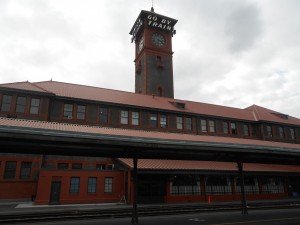
Santa Fe New Mexico
The Santa Fe train depot was built by the AT & SF Railroad. The Santa Fe railroad main line was never built directly to Santa Fe due to the 7,000 foot elevation of the town.
During the survey period it was determined that there existed too many topographical challenges to make Santa Fe a mainline stop. The train depot in Santa Fe was built to handle the branch line that was built between the Lamy New Mexico station (about 20 miles southeast of Santa Fe) and Santa Fe proper.
This station was also built in the Mission Revival style of architecture and today serves two purposes. The old Santa Fe rail station is the northernmost stop for the New Mexico Rail Runner commuter train. The Rail Runner route extends from Santa Fe southward to Albuquerque and then to Belen New Mexico as it’s southernmost point. The second use of the train depot is as the starting point for the Santa Fe Southern Scenic Railway day excursion.
See the story and photos of the historic Lamy Train Station which is still in operation today.
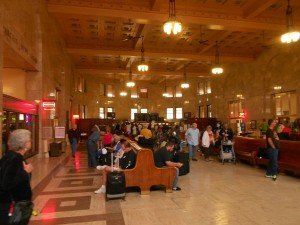
The scenic route leads from Santa Fe down to the Lamy station. The Lamy station today serves as the Santa Fe stop for Amtrak’s Southwest Chief, the Chicago to Los Angeles daily train.
Union Station-Portland Oregon
Built in 1896, here remains a beautiful train station that overflows with Pacific Northwest history. The station was built in a Queen Anne and Romanesque style with a 150 foot high clock tower that holds a four sided Seth Thomas clock. The building went through a restoration in 1927 which added Italian marble to the walls and floors. In 1987, the Portland Development Commission purchased the train station and it’s thirty-one adjacent acres.
Today, Union Station serves as the Portland stop for Amtrak’s hugely popular Coast Starlight train which runs between Los Angeles California and Seattle Washington. One of the most scenic of the Amtrak routes.
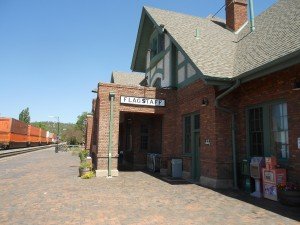
Flagstaff Arizona
The city of Flagstaff has done an outstanding job in restoring it’s old train depot as well as the historic downtown district in general. The Tudor Revival designed depot was built in 1926 by the Atchison Topeka & Santa Fe Railroad. The building housed a baggage and express area with the agents office and waiting room in the center. The depot had tri-color walls of bright red, dark red and orange bricks. Next to it is the the 1886 solid red sandstone freight depot that originally was constructed by the Atlantic and Pacific Railroad. Prior to that, the station consisted of two box cars. The train station was and is located on historic Route 66 and today houses the Flagstaff Visitors Center. The station also serves as the passenger stop for Amtrak’s Southwest Chief with daily service from Los Angeles to Chicago Illinois.
See our article and photos of the present day Amtrak Southwest Chief, one of the more popular of Amtrak rail routes.
Danville California
This town located just east of the San Francisco Bay Area and near Mount Diablo has done a superb job in restoring their old historic train depot. Danville was not on mainline transcontinental route like Flagstaff Arizona and Las Vegas New Mexico but was a key element in the growing of the San Ramon Valley.
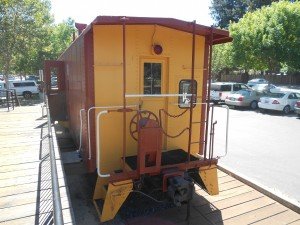
The Danville Branch of the Oakland Antioch and Eastern Railway served the towns of Alamo, Danville and Diablo from 1914 to 1924. The Sacramento Electric Railroad served the town and county from 1929 to 1941. Passenger service ended that year. During it’s existence, the Sacramento Electric Railroad was the nation’s longest interurban electric railroad. Electric railroads served as a sort of transition between the steam trains and the automobile era. Today, the train station at Danville is an excellent museum highlighting everything about the San Ramon Valley and the railroads that operated there. The museum features rare artifacts and equipment and has special exhibits and programs throughout the year.
(Photos are from author’s private collection)
